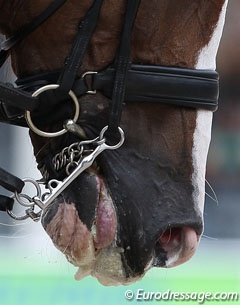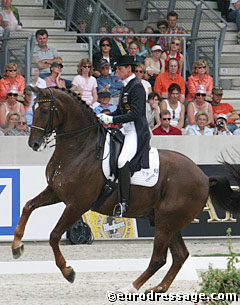
On 1 July 2011 FEI Dressage Judge General Ghislain Fouarge issued the following judging guidelines for the evaluation of the pirouettes as well as contact and mouth problems. In his memo Fouarge makes an important statement on contact which all judges should take to heart!
"When a horse is presented showing a good acceptance of the contact judges should mark in a very positive way in order to encourage good riding. Even where there are small mistakes in the test a good correct contact must be rewarded under submission," Fouarge wrote. His next sentence is very important as this issue often seems disregarded in the judging of dressage tests: "A faultless test where the contact is forced or showing resistance must be considered of a lesser quality."
Read Mr Fouarge's guidelines here:
Canter pirouettes
Definition: The pirouette (half-pirouette) is a turn of 360 degrees (180 degrees) executed on two tracks, with a radius equal to the length of the horse and the forehand moving around the haunches. The forefeet and the outside hind foot move around the inside hind foot. The inside hind leg describes a circle as small as possible. The horse, slightly bent in the direction in which it is turning, remains “on the bit” with light contact, turning smoothly around, and maintaining sequence and timing of footfalls of that pace. The poll remains the highest point during the entire movement.
MORE SIMPLE :
The canter pirouette is a turn on the haunches in canter around the inside hindleg, with the horse bent and flexed in the direction of the turn. The radius is equal to the length of the horse.
Positive Points:
- Rhythm: Rhythm should be clear, steady and in a genuine three beat before, after and during the pirouette.
- Bending: Bend and flexion is shown in a uniform way to the inside with a supple contact and the head slightly in front of the vertical
- Collection: The horse bends the haunches, flexes the hind leg joints and really takes weight behind. Lowering of the croup and clear self-carriage.
- Size: On a small radius and controlled.
- Execution: Executed in the correct place with a straight approach and depart. Correct number of strides – single pirouette 6-8 strides, half pirouette at least 3-4 strides. The outside hind foot should engage and track forward under the body of the horse without any deviation to the outside. The inside hind leg and outside front leg are not touching the ground simultaneously. The pirouette should be centered and the horse should not step out or sideways and not be on a small circle.
As a general principle the judge should assess the overall potential of the pirouette to develop into the best quality.
Evaluation and smaller faults
For top marks of 9 or 10 the pirouette must be almost on the spot. Up to 1 meter is allowed but any larger than this cannot be considered a high quality pirouette. The movement becomes a working pirouette if bigger than 2 meters and would not score higher than 5 or even less depending on size.
In the small tour positive marks can be given where the pirouette is ridden a little large but in a good way (but not bigger than 2 meters ) This will encourage riders to have the horse more in front of the aids with a good energy and beat. This can score a 7. Not enough bend is a smaller fault and can still achieve a 6.
The rhythm can be slowed very slightly but it has to be the same rhythm as the regular collected canter of the horse, the strides should not become labored.
The number of strides (6-8 and 3-4) is important and less experienced judges should count them to be certain how many have been made. In most cases where the overall impression is good the number of strides is correct. When a horse clearly shows too few jumps the mark cannot be higher than 6.
Coming to high in the neck or climbing would not be higher than a 5. Where there is a backward tendency the mark would be 5 or less depending on severity.
Rhythm in the pirouette
When the horse changes behind (in cross canter) this is clearly a deviation from the correct rhythm and would never score higher than a 4. If the horse looses the canter for just one stride the mark would be 4 but if more than 1 stride not higher than 3 (falling in a clear walk or trot).
If the hind legs are almost parallel or together behind for one stride the mark would be 5 but lower if more than one stride. These mistakes can be marked more severely when the pirouette is also very large but more favorably where the rider has taken a risk and made it very small.
In the pirouette the rhythm appears to be a three beat although with small pirouettes this is almost impossible. There is much theoretical discussion based on slow motion recordings but this should not cloud the judge’s assessment. There may be a slight hesitation but the canter gives the impression of a clear beat.
Approach to and departure from the pirouette
 The approach should be straight or with a slight shoulder in position. At least one point should be deducted when the approach is quarters in.
The approach should be straight or with a slight shoulder in position. At least one point should be deducted when the approach is quarters in.
If, on the approach, the horse looses the canter for one stride but then regains it immediately deduct 1 point.
Where there is much resistance for example clearly against the bit during the approach or many strides are lost deduct 2/3 points.
If the pirouette or the half pirouette is not quite completed and the departure is therefore crooked the mark would not be higher than 6. When the horse overturns and the control is lost the score would never be higher than 4.
The horse should be clearly collected and prepared before the pirouette but not for too long – only 2-3 strides (max 4 strides) – and always in a clear quality three beat canter .
If, in the Prix St Georges, the horse changes before the corner marker the fault should be considered in the mark for the counter canter and not the one for the pirouette. This is more fair to the rider as the pirouette has a co-efficient and may have been shown well.
Walk pirouettes
The principles are almost the same as for the canter pirouette. The pirouette is a turn on the haunches from walk and executed out of Medium walk (for ponies and young horses) prepared by half halts to shorten the steps and to collect the walk to improve the bend of the joints of the hindquarters or directly out of collected walk (advanced horses).
The horse does not halt before or after the turn. The walk should be collected, not slow, with active even steps in a clear four beat. The horse should show a willingness to close behind. Some horses avoid closing by stepping out, crossing the inside hind leg in front of the outside hind leg, stepping sideways or even stepping back. In some cases the horse steps wide or loses the clear four beat rhythm.
Evaluation
If the pirouette is shown a little large but in a good way the mark can still be 7. When the rider makes the pirouette very small it should be given a high mark, when the quality and correctness is maintained.
If the pirouettes goes wrong because the horse is for instance overactive, mark more kindly than when the mistakes are related to a lesser quality of the riding.
If a horse rears or is very resistant the score cannot be higher than 1 or 2.
It can happen that a walk pirouette is executed in a correct four beat rhythm whilst the collected walk between is not regular. The pirouette should be marked positively and points deducted only from the special mark for the collected walk itself.
Contact and mouth problems
When a horse is presented showing a good acceptance of the contact judges should mark in a very positive way in order to encourage good riding. Even where there are small mistakes in the test a good correct contact must be rewarded under submission. A faultless test where the contact is forced or showing resistance must be considered of a lesser quality.
Problems with the contact and how to deal with them
Under the present rules if blood is showing there is no discussion – the horse must be eliminated immediately. The welfare of the horse is paramount.
A horse going with an open mouth should be dealt with by deducting 1 or 2 marks each time it is observed depending on severity. Issues with the tongue are further evidence that the horse is avoiding the contact and has problems to accept the right contact through the bridle.
Where the tongue is drawn right up or over the bit the mark would be taken down by 2 or 3 points for each time it is clearly observed. The same would apply where the tongue is hanging out to the side and this fault would never score higher than 5 per movement. If the tongue is clearly over the bit not more than 4.
 In some cases the tongue shows a very small amount at the front of the mouth. When this is approximately some mm it can be ignored. When this becomes exaggerated then 1 or 2 marks should be deducted depending on severity.
In some cases the tongue shows a very small amount at the front of the mouth. When this is approximately some mm it can be ignored. When this becomes exaggerated then 1 or 2 marks should be deducted depending on severity.
When a horse is momentarily a little behind the vertical but the overall picture is willing and on the aids the fault is not severe. If the horse is short in neck or too deep in front for a longer time at least 1 point would be deducted per movement (also for the Halt). The whole execution of the movement should be judged.
Sometimes the horse is correctly in front of the vertical, but it is clear that the contact is strong and that the horse is not through enough or leaning on the bit. In such cases at least 1 point would be deducted per movement.
Moving the lips is not a fault and can be ignored if the way of going is willing and in every other way correct.
Grinding the teeth is not considered a fault if the horse appears happy and willing and has saliva.
Slight tilting will result in the deduction of 1 point per movement but 2 points where more severe.
Judges should keep in mind that problems with the contact also influence the mark given for submission. Severe problems with the tongue coming out or over the bit would result in a maximum of 5 for submission. If however, the contact is good then the judge should be prepared to go up with the submission mark.
-- by Ghislain Fouarge for the FEI
Photos © Astrid Appels
Related Links
Judging Guidelines for the Evaluation of Piaffe, Transitions and the Walk
Fouarge Elected First FEI Dressage Judge General